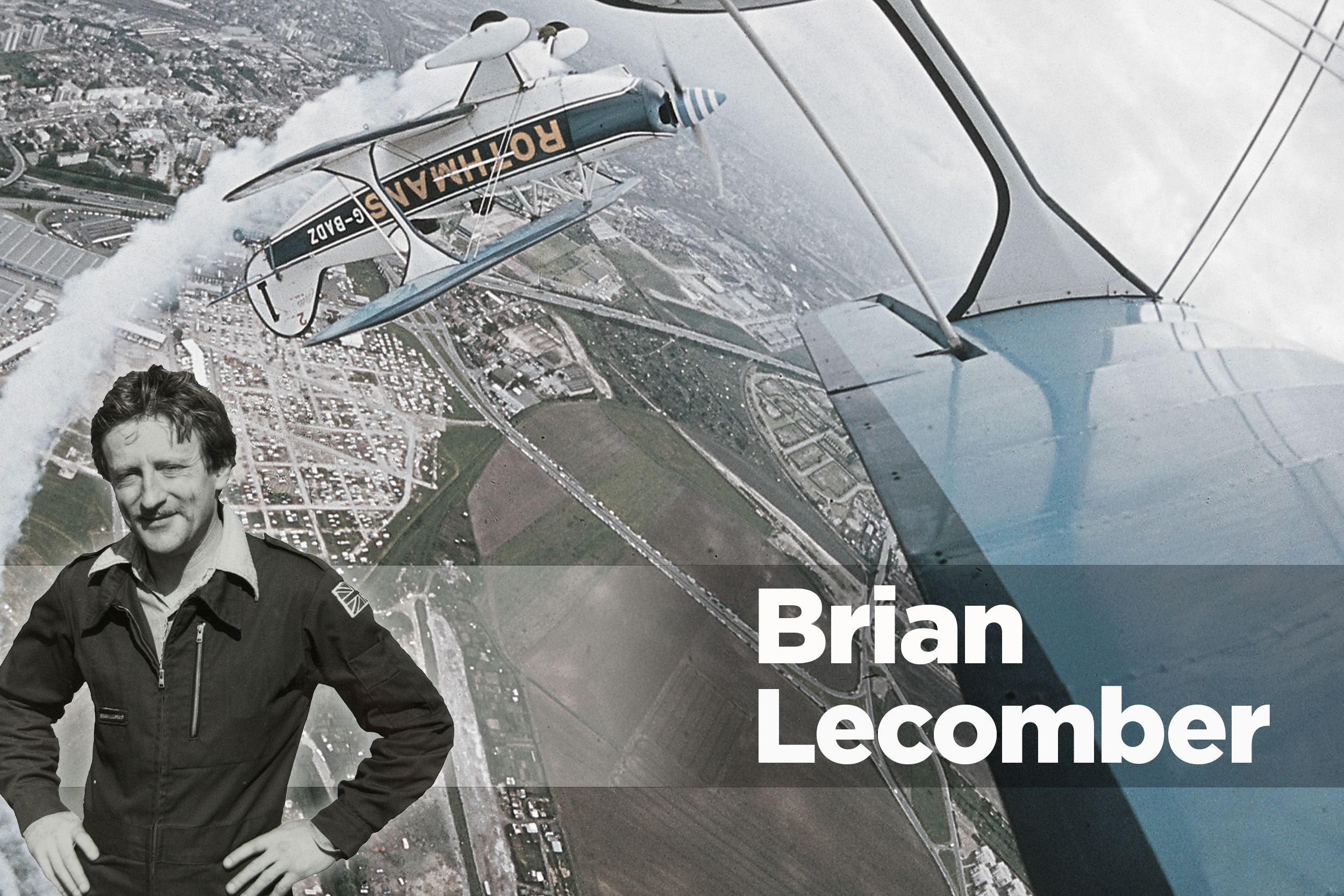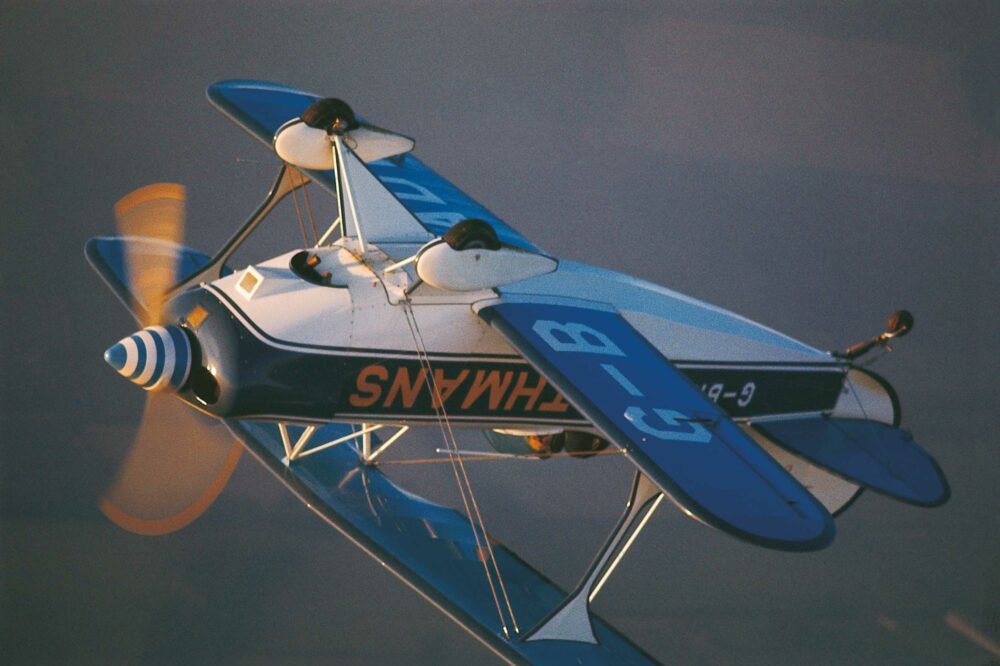Bless all of you. In an instant perhaps 300 people are standing aside so that one very frightened Blue Four, in his horribly shaking Pitts Special, might have the pick of his possible salvation.
Then, abruptly, there is no salvation.
In an instant, without any change of engine note, the windscreen becomes obliterated by brown oil. Just like that – one second nothing, next second an un-heard SPLAT and no forward visibility. At all. Nothing but black-brown oil runnelling up the screen.
Oil pressure now zero. Oil temp irrelevant, there now being no oil to take the temperature of. The vibration worsens further, and I fancy I can actually hear a metallic clattering.
Suddenly, now, I no longer hanker for that nice warm full canopy. If I had it, it too would be obliterated by streaming oil, and I would have to slide it back and abandon it – perhaps taking a chunk of tail with it. As it is I can see around the windscreen by craning left and right…
“Lead, Four; I’m blind forward. Can you go ahead and lead me to Teesside?”
“I’m behind you. Can you orbit to let me catch up?”
“Negative. Just give me steers, please.”
I peer round the edges of the windscreen as best I can. Just 10 miles. Five minutes of flight. Surely you can manage just five minutes, engine?
But I know it won’t. In truth I don’t know how I know – but somehow, in my bones, I feel a kind of tightening in the shuddering ague of the engine. This ain’t gonna run no five more minutes without oil…
“Lead, Four; this thing’s going to seize any moment. Going into a field.”
“Rog, Four.”
Part of my cringing mind has been paying most rapt attention to the terrain passing below ever since the first cough. Which was maybe three minutes – or perhaps three lifetimes – ago. There is a field approaching my shivering right wing which I’ve had my eye on for at least 30 seconds. It is ploughed – in this fertile county almost all fields are ploughed at this time of year – but the furrows are at least roughly into-wind. And it seems to be the longest within reach…
Ha! Blue Four, you self-styled clever pilot, are you so clever that you can eyeball the landing distance available in one field amidst a host of others? Or are you just picking it because it’s the longest one in sight, when in fact they’re all too small in the first place?
I do not know.
Ho! And how will a Pitts Special with its tiny wheels land in muddy clinging furrows even if the field is long enough?
I do not know.
I have forced-landed before. But only in slower aeroplanes mostly with big puffy tyres. How will the Pitts behave at twice the speed in clinging mud with its very little wheels?
I have no idea. I do not know.
And I am very frightened.
There is not, however, any more choice. I ease the throttle shut.
The engine starts to die and then promptly seizes. Better now than at higher power when it might have thrown itself out of the airframe. Sideslip… stare at the field out of the side… slip between two trees… straighten… look out the side because I can see nothing ahead… bounce off the first touch…
And distinctly hear the voice of my old Chief Flying Instructor, now sadly deceased, in my ears. He says, “Why don’t you take the f***ing brakes off, Brian?”
My toes come off the brakes. I simply didn’t know I was standing on them. The Pitts lands again and stays landed, my right hand trying to haul the stick back through my solar plexus.
The Pitts stops. It doesn’t overturn. It doesn’t get anywhere near the far hedge.
I am a lucky man this day. I am a very lucky man.
I switch everything off and climb out. Stagger to the wingtip, breathe deeply and do not quite vomit. Blue Lead circles over me and drops cigarettes and a lighter, which I cannot be bothered to find. I stagger over the ploughed field to the distant farmhouse, knock on the door and explain to the farmer that I have just placed an oil-soaked and terminally unwell aeroplane in one of his fields, which at first he seems disinclined to believe. Bidding me to come with him – possibly to avoid my darting in and nicking the family silver – he walks out until he can actually see the Pitts standing forlornly in the middle of what will be this summer’s prime wheat-crop. Then his warm family invite me to a perfectly delicious Sunday lunch. And are polite enough not to notice that my knife and fork rattle on the plate rather more than is called-for.
I have been a very, very frightened man this day.
This is what a forced landing is like. For real.
As a matter of record the Pitts engine had fractured a piston-crown, and as the piston disintegrated the crankcase pressure increased until it blew out the front crankshaft oil-seal. Whatever that now-ancient Pitts eventually dies of, it sure ain’t gonna be rust.
As a further matter of record I was doubly lucky that day. The mechanical post-mortem revealed that the engine malady had in fact been festering for some time, like a weakened aorta lying in wait to let go. It let go over English farmland. Five flying hours earlier I’d been flying that same aeroplane with the team past the cloud-enshrouded and deeply rain-forested 13,000ft Mount Kinabalu in Borneo. If it had let go then you wouldn’t be reading this story.
Did fright hamper me in this emergency? Did fright – especially given time to blossom into stomach-churning fear – speed my reactions or slow them down?
After many years, I still do not know. I think it probably slowed them.
What I learned for sure is that when it happens for real you have to conquer fear as well as the problem – and that fear may indeed be the greater part of the problem.
- It costs just £5 per month to join The FLYER Club. You’ll get access to all of our content, our FREE landing fees every month, the weekly members’ Livestream on Wednesdays, plus our monthly webinar. Join today by visiting flyer.co.uk/membership







